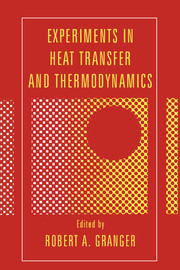Book contents
- Frontmatter
- Contents
- Preface
- Introduction
- Part I Experiments in heat transfer
- I.1 Conduction
- I.2 Convection
- I.3 Boiling
- I.4 Mixing, dispersion, and diffusion
- I.5 Radiation
- I.6 Heat pipes and exchangers
- Experiment 24 Performance characteristics of an annular heat pipe
- Experiment 25 Heat transfer during drop formation and release
- Part II Experiments in thermodynamics
- Appendix 1 Experiments and demonstrations in thermodynamics
- Appendix 2 Experiments and demonstrations in heat transfer
- Appendix 3 Heat-transfer and thermodynamic films
- Index
Experiment 25 - Heat transfer during drop formation and release
Published online by Cambridge University Press: 05 June 2012
- Frontmatter
- Contents
- Preface
- Introduction
- Part I Experiments in heat transfer
- I.1 Conduction
- I.2 Convection
- I.3 Boiling
- I.4 Mixing, dispersion, and diffusion
- I.5 Radiation
- I.6 Heat pipes and exchangers
- Experiment 24 Performance characteristics of an annular heat pipe
- Experiment 25 Heat transfer during drop formation and release
- Part II Experiments in thermodynamics
- Appendix 1 Experiments and demonstrations in thermodynamics
- Appendix 2 Experiments and demonstrations in heat transfer
- Appendix 3 Heat-transfer and thermodynamic films
- Index
Summary
Principle
The resistance to heat transfer in a liquid–liquid direct-contact heat exchanger is found to exist mostly in the dispersed phase. An exception is the drop formation and release process, where the resistances to heat transfer in the continuous phase and the dispersed phase are often of the same order of magnitude. Temperature measurements combined with high-speed motion photography allow one to determine the dispersed-phase and continuous-phase resistances as well as the heat-transfer efficiency.
Object
The objective of this experiment is to determine the heat-transfer efficiency of the drop formation process, and to find the internal and external heattransfer coefficients immediately following release. The liquid–liquid system described here uses hot water as the continuous phase and cold AMSCO petroleum solvent (oil) as the dispersed phase.
Background
Most liquid–liquid direct-contact heat exchangers consist of a vertical spray column. The dispersed phase, which has a lower density than the continuous phase, is injected at the bottom of the column through a nozzle or a set of nozzles and flows upward in the column in the form of drops. The continuous phase is injected at the top of the column and flows downward.
The problem of finding a nonintrusive method to measure the internal temperatures of a developing drop has not been solved. Some researchers have attempted to measure the average drop temperature in the free-rise section of the spray column by effectively changing the column height and measuring the temperature of the dispersed-phase fluid after coalescence.
- Type
- Chapter
- Information
- Experiments in Heat Transfer and Thermodynamics , pp. 192 - 200Publisher: Cambridge University PressPrint publication year: 1994



